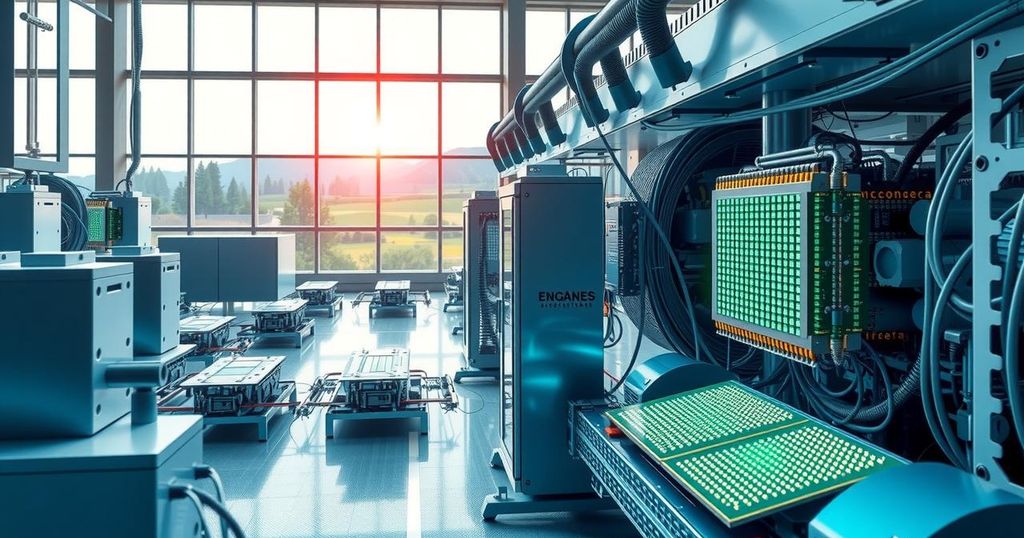Malaysia’s Bold Move to Transform into Semiconductor Powerhouse
Malaysia aims to reposition itself as a key player in the semiconductor industry with the National Semiconductor Strategy, targeting over $107 billion in investments. The focus will shift from traditional assembly processes to advanced technologies, while initiatives to train 60,000 engineers and foster local startups will bolster its capabilities. A collaborative approach with global partners seeks to enhance the supply chain amid geopolitical tensions.
Malaysia is standing firmly in the race to become a key player in the global semiconductor supply chain, with a bold plan laid out by Prime Minister Anwar Ibrahim. The National Semiconductor Strategy (NSS), launched in May 2024, sets an ambitious goal of attracting more than MYR500 billion (about $107 billion) in investments from both the public and private sectors to enhance the country’s semiconductor capabilities, according to reports from Reuters.
Historically, Malaysia has mostly been associated with back-end processes in semiconductor manufacturing—areas such as assembly, testing, and packaging, with giants like Intel and Infineon operating within the country for years. However, the NSS signifies a pivotal shift. This new strategy aims to advance Malaysia into higher-value segments, including chip design and R&D, as noted by ASEAN Briefing.
This strategic pivot resonates with the wider trend as nations globally scramble to fortify their semiconductor capabilities amid geopolitical tensions and supply chain disruptions. As The Diplomat pointed out earlier in 2025, Malaysia’s neutrality in the ongoing US-China relations positions it uniquely, becoming an appealing destination for companies looking to diversify away from Taiwan and mainland China.
At the heart of the NSS lies a robust investment framework aimed at attracting foreign and local businesses alike. The government has committed MYR25 billion (approximately $5.3 billion) in incentives, incorporating tax exemptions, grants, and supportive infrastructure, as highlighted by Free Malaysia Today.
In parallel to this, the Malaysian Investment Development Authority (MIDA) is actively pursuing partnerships with major semiconductor firms from the US, Europe, and Japan. Significant projects, such as Intel’s $7 billion expansion in Penang and Infineon’s €5 billion initiative in Kulim, provide early validation of the strategy’s effectiveness, reported TIME in April 2024.
Talent development plays a crucial role in executing the NSS, as Malaysia recognizes the pressing need for skilled engineers in this sector. The initiative includes plans to train 60,000 local engineers, including new curricula in collaboration with universities and training partnerships with firms like ARM and Synopsys, as per reports from Malay Mail.
To bridge educational divides, the Ministry of Higher Education is endorsing “dual-training systems” that blend theoretical knowledge with practical factory exposure. This approach not only mitigates the ongoing skills deficit but also aims to retain top talents by offering competitive salaries, according to KR Asia.
A significant aspect of the NSS is the ambition to nurture at least 10 local companies specializing in advanced packaging and integrated circuit design, each targeting revenue streams between MYR1 billion and MYR4.7 billion (about $210 million to $1 billion) by 2030. Government-linked investors such as Khazanah Nasional are developing funding initiatives to bolster local startups focused on deep tech, moving beyond merely hosting multinational corporations, as emphasized by Digital News Asia.
Malaysia’s geographical and political advantages greatly enhance its attractiveness for semiconductor endeavors. The country’s strategic location offers strong infrastructure and logistics, especially in regions like Penang and Johor, which are critical for the time-sensitive semiconductor industry. As noted by The Diplomat, Malaysia’s involvement in regional trade agreements also bolsters its position as a prospective semiconductor hub.
The NSS is not primarily about competition with semiconductor powerhouses. Instead, it adopts a collaborative approach, promoting joint R&D initiatives and inviting foreign investment to create innovation parks and pilot projects. Partnerships are being actively explored with nations like Japan, Vietnam, and Singapore to create integrated regional value chains, as reported by Free Malaysia Today.
This regional collaboration aligns seamlessly with Malaysia’s commitment to sustainability, focusing on environmentally friendly manufacturing practices. As tech firms increasingly prioritize environmental sustainability, the country is working to carve out its niche as an eco-conscious semiconductor production base, as noted by TIME.
Despite the challenges posed by established tech giants and emerging players like India and Vietnam, Malaysia’s well-structured and funded NSS positions it favorably in this competitive market. The success of this venture will hinge on the government’s ability to develop talent, uphold investor trust, and spur domestic innovations. Malaysia’s substantial commitment to semiconductors is undoubtedly about much more than just infrastructure—it is a strategic investment in the country’s technological future.
In conclusion, Malaysia is making a strategic push to elevate its role in the global semiconductor industry through the National Semiconductor Strategy. With ambitious investment goals, a focus on talent development, and a commitment to fostering local enterprises, the country aims to carve out a significant share in this critical market. If executed successfully, Malaysia could transform from being a regionally significant player into a global semiconductor heavyweight, thereby ensuring its technological sovereignty for the long term.
Original Source: www.intellinews.com




Post Comment